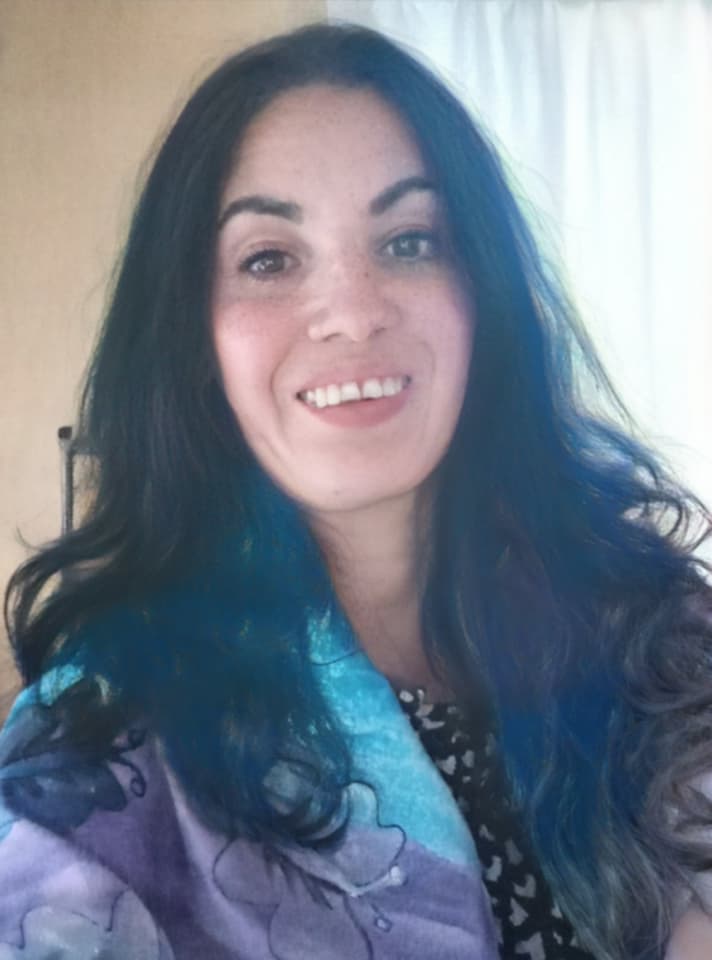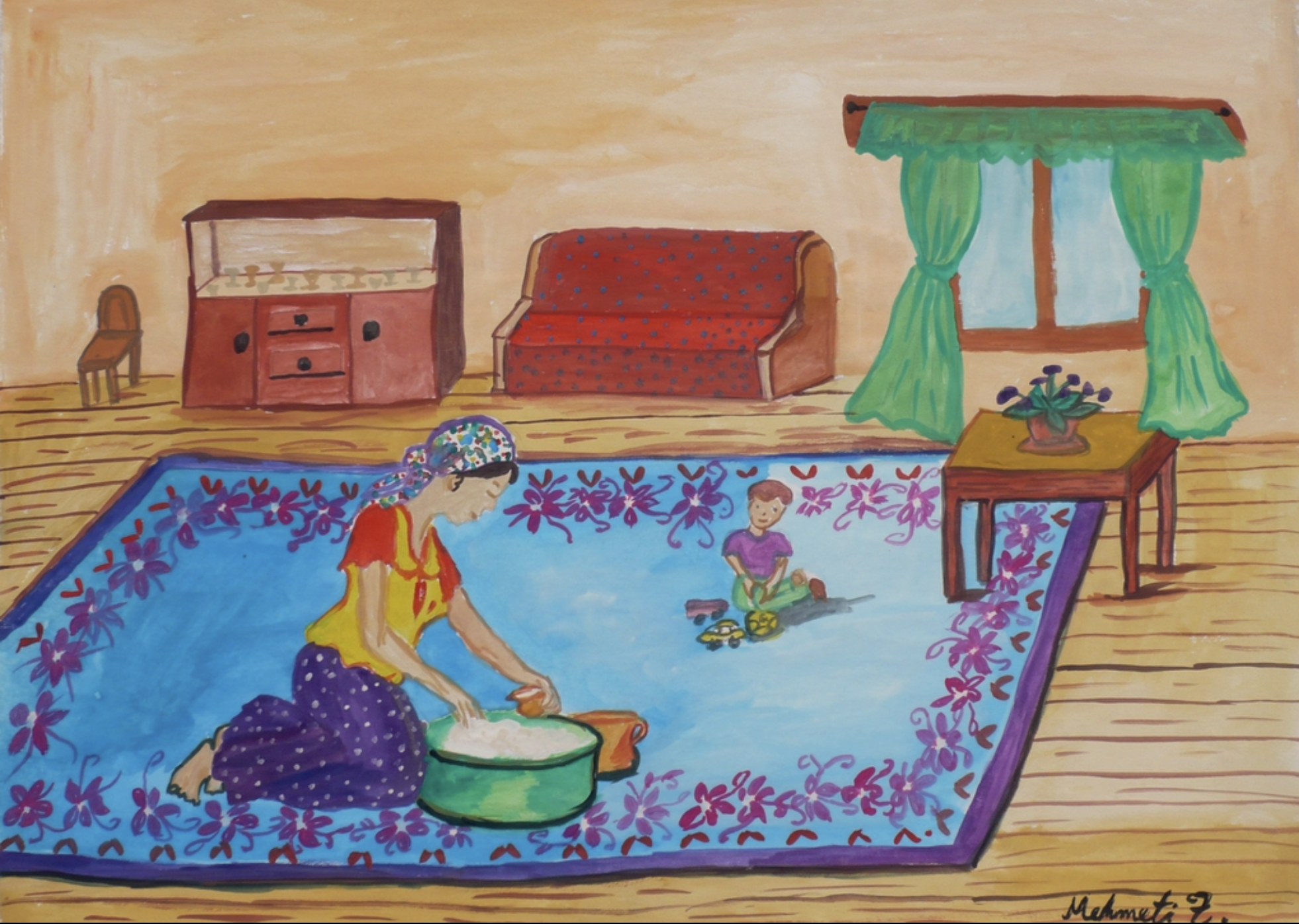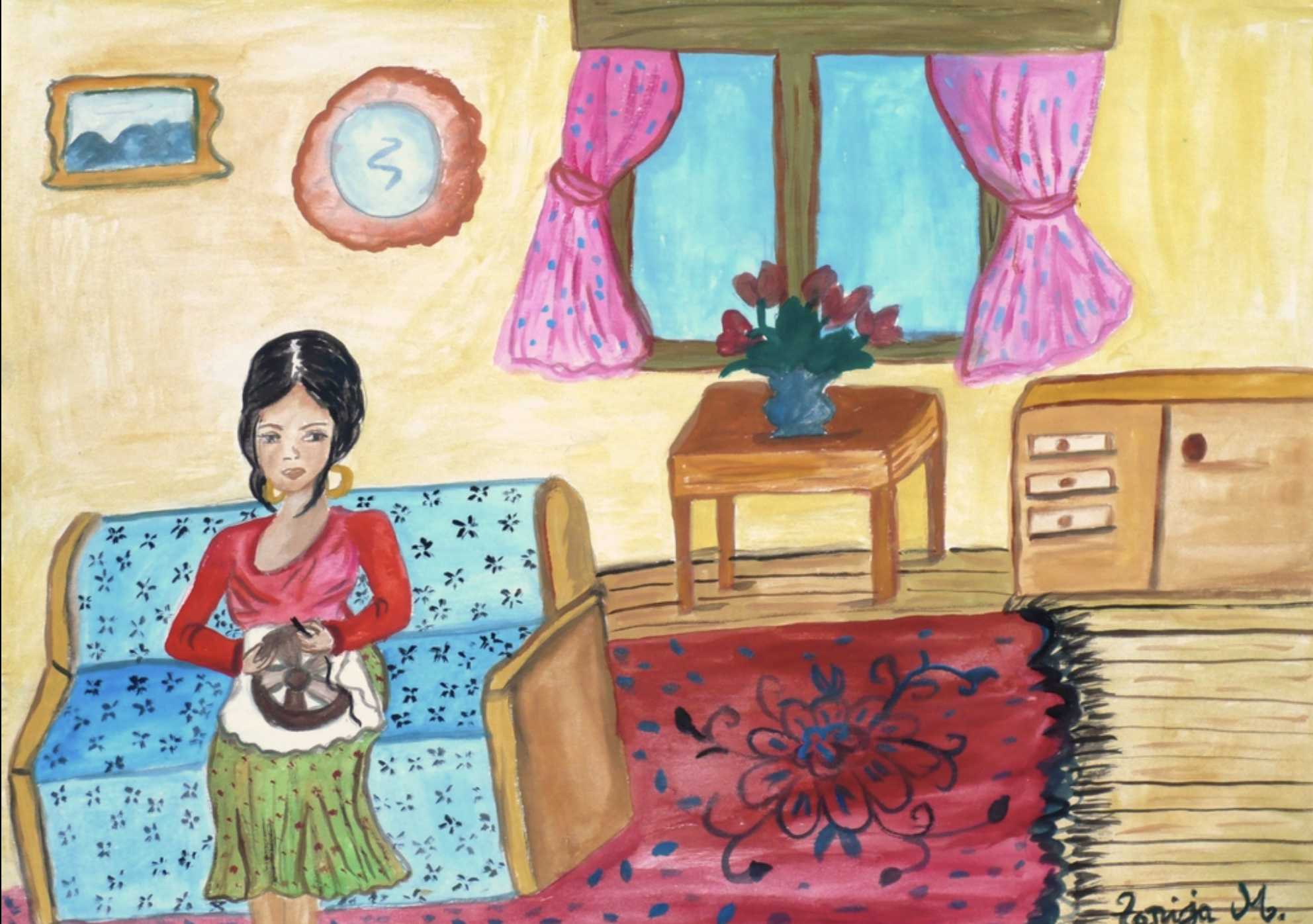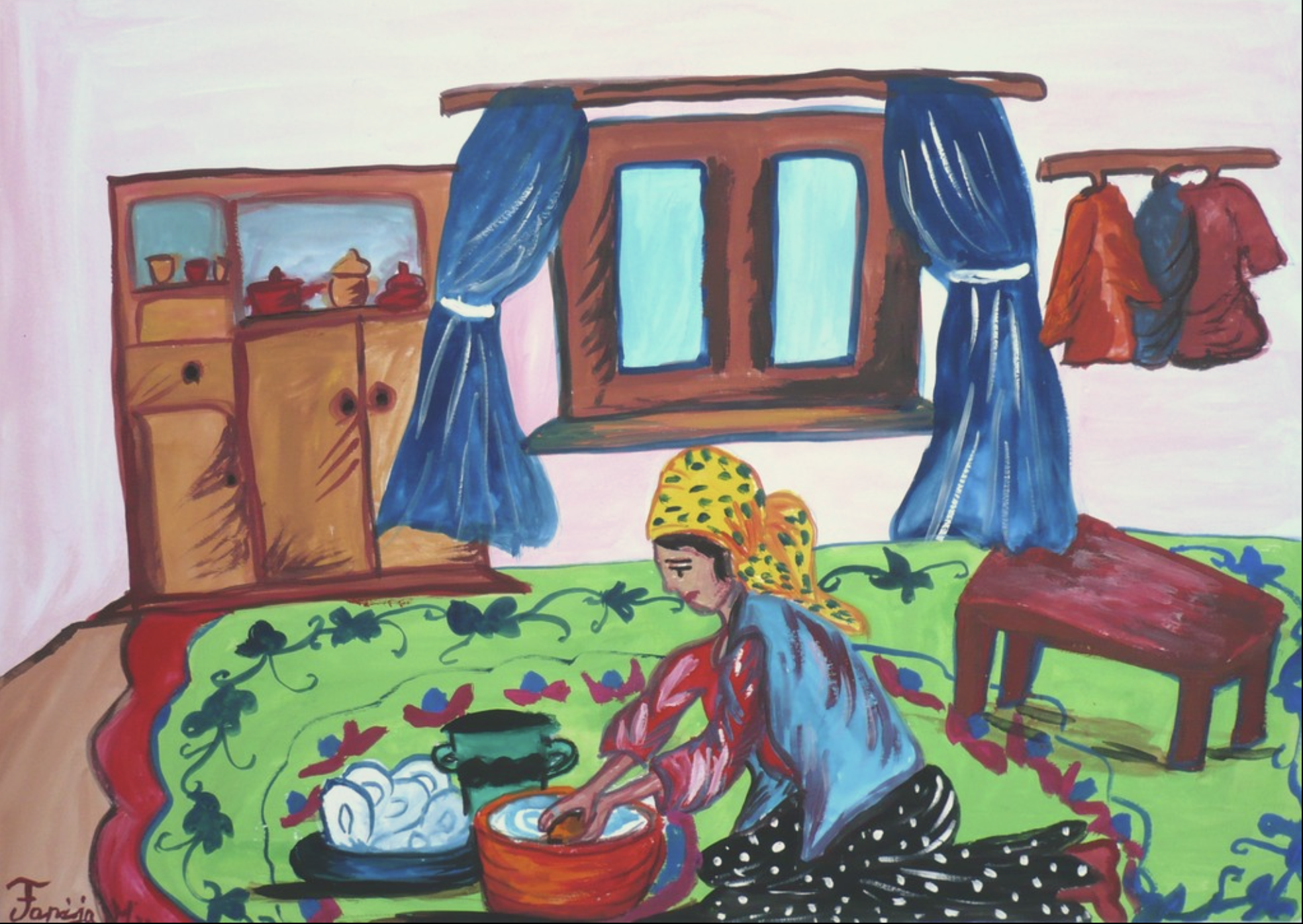



I was born in Pristina in 1978 and live in the village of Lepina. I started painting in 2001 after watching my brother Bajram paint scenes of Roma life. I paint portraits of Romani women, mostly from imagination, showing their colourful way of dressing up to preserve this tradition and the culture of the Roma. My first exhibition was in 2011, together with my brother, in the Oda theatre in the framework of the Roma Festival. My second exhibition, the first independent one, was in Pristina in September 2011, organized by SURF. My third exhibition was in April 2012, together with my brother in the National Arts Gallery, on the occasion of the International Roma Day, 8th April. This exhibition was organized for us by the National Arts Gallery, the American Embassy, and the Kosovo Ministry of Foreign Affairs
I began painting around 2001, shortly after the war in Kosovo. My brother Bajram, who was already depicting Roma life through drawing and painting, encouraged me to give it a try as well. Initially, it was merely an interest, and I started experimenting with drawing women models. In the early 2000s, I met Paul Polansky, a writer and activist for Roma rights. He encouraged me to try and represent my community. Gradually, I uncovered what felt like a calling. Through practice and persistence, I realized I had discovered a language that allowed me to express something deeply personal.
My work centers on Roma women — not just their figures or faces but the richness of their presence, their strength, and their inherited aesthetics. One of the main visual motifs I return to is the headscarf, or marama, an important element of Roma culture. These scarves were once part of everyday dress for women in our community. My grandmother collected them, and I remember how bold, floral, unapologetically vibrant colors seemed to speak even when words fell short.
Today, many of us no longer wear them daily, but their memory lingers. In my paintings, I bring them back as nostalgic elements and as a form of visual continuity, a way to honor Roma women’s histories and their silent labor. Each scarf in my work comes from the imagination, but it’s rooted in memory. I paint them in motion, layered, expressive, often as the first thing I see when I close my eyes.
Beyond portraits and scarves, I paint everyday scenes from Roma life: women cooking, doing laundry, and preparing food. These moments reflect the kind of labor that often goes unseen and unrecognized. It’s work that sustains families and communities, yet it rarely receives value or visibility.
My artistic practice is shaped by the everyday realities of being a Roma woman in Kosovo. I often work with limited materials, paints on canvas, or textiles when possible. I also sew small bags, scrunchies, and I dream of one day creating a full traditional Roma outfit through my art. But resources are few, and time is often occupied with responsibilities. Still, I return to painting because it brings me peace and it grounds me.
Social and political realities have never been separate from my work. Roma women are underrepresented, often invisible in both art and public life. Many marry young, some without choice. With my art, I want to show that there are other paths we can take, that beauty, imagination, and agency belong to us, too. I paint women as bearers of color, history, and dignity.
I create because I refuse to be invisible, as a Roma and as a woman. I paint for others to see our colors, and I insist on being seen in all our complexity.
The text was written in collaboration with Anyla Kabashi.
12
3
4
5
6
7
8
9
10
11
12
13
14
15
16
17
18
19
20
21
22
23
24
25
26
27
28
29
Bijandilem ande Prishtina 1978.brsh thaj trajiv ando gav Lepina. Teljardem te lavavav 2001. Brsh. Palem so dikhlem mungre phrales Bajrames sar lavarel o rromano trajo. Me lavavav e pilte katar e Rromnja, save si man ando shero, lengo kotoralo hurjavipe thaj gajda arakhav e tradicija thaj kultura e Rromendji. Mungrro angluno sikadipe e piltengo sas 2011. Brsh, khetane mungrre phralesa ando Teatro Oda, sar kotor katar o Rromano festivali. Mungrro dujto sikadipe e piltengo, sar vi angluni,sar korrkoro lavavni, sas ande Prishtina ando Septembri 2011. Brsh priko SURF. Trito sikadipe sas ando Aprilo 2012. Brsh palem khetane mungrre phralesa ande Rashtrachji artistikani galerija, palo mashkarthemutno djes e Rromengo, 8. Aprilo. Palo kava sikadipe dijame shaipe e Rashtrachji artistikani galerija, Ambasada katar e Amerika thaj Ministeriumo pale avrutne buća katar o Kosovo.
Teljardem te lavavav trujal 2001. Brsh, na but vrjama palo maripe po Kosovo. Mungrro phral o Bajram, savo lavavelas o rromano trajo, thaj dija man troma te vi me lavavav. Po teljaripe kodova sas numa kamipe, thaj teljardem te zumavav te lavavav dzjuvljikane figure. Po teljaripe kater e 2000 brsha pindzjardem e rajes Pol Polanski, lilvarnes thaj aktivistos pala rromane orte. Vov dijama dumo te zumavav te sikavav mungro naciono. Polochje hachjardem kaj godova si vareso so me kamav te buchjarav ando trajo. Priko sichjope thaj zuralo kamipe arakhlem chib saji delma shaipe te mothav koja so hachjarav.
Mungrro buchjaripe si chutino pe Rromnja, na numa pe lenge figure thaj muja, numa vi po barrvalipe katar lengo ačipe, zor thaj genetsko estetika. Jekh katar e motivurja saveske sajekhdrom boldama si o dikhlo, importantno kotor ande rromani kultura. Ando dumutnipe e dikhle sas sajekhdjesesko huvrjavipe kaj manushnja andar amaro naciono. Mungrri mamia chjidelas len thaj dama gođi sar sas zurale farbe save mothonas majbuit katar e milja alava.
Adjes but amendar chi phiravas len, sasjekhdjes numa vi majdur dasame godji pe lende. Ande mungrre pilte boldav len vi sargo purano kotor vi sargo vizuelno lundzjaripe thaj drom te dav historikano pachjiv Rromnjenge thaj lengo lokorrimasko buchjaripe. Sajekh dikhlo ande mungri pilta avel andar mungrro shero, numa o fundo si sar me dama lenge godji. Lavavav len ando mishkope, zurales majbutivar sargo angluni pilta kana phandavav mungre jakha.
Pasha patrina thaj dikhla, lavavav vi sajekhdjsesko rromano trajo: rromnja sar chjiraven, halaven e drze, chjeren o habe. Kodola si vareso so butivar naj hachjardo thaj naj sikado. Kodova si o buchjaripe kaj chjidel e njamonen khetane, numa chi delpe leske importancija thaj dichjipe.
Mungrro artistikano buchjaripe chjerel sajekhdjesesko chacho trajo e Rromnjengo pav Kosovo. Butivar buchjarav na but maetrijalosa, farbenca palo tekstili, save shaj arakhav. Suvav trjastice, ricice palaj bal thaj mangav te jekh djes chjerava sasti tradicijonalno romano hurjavipe priko artistipe. Resursurja si chore, a naj but vrjama andar aver buchja saje si amnge musaj. Palem boldama piltenge andar godova kaj anen mange hachjaripe po miro thaj achipe.
Themeshchje thaj politikane chachimata ni jekh drom nas chute avri andar mungro buchjaripe. Romnja najbut dikhline, butivar si bidikhline sar ando artistipe gajda vi ando trajo. But den ando abjav terne varesava vi bi lenge kamilmatako. Priko mungro buchjaripe kama te sikavav kaj si vi
aver droma thaj kaj amen si vi vareso shukar , lache gindurja thaj losarimaski zor. Lavavav e rromnjan sargo kola saje indjaren e farba, dumutnipe thaj vorta achipe.
Buchjarav andar godova kaj chi kamav te avav bidikhlini sargo Rromnji thaj sargo manushnji. Lavavav te bishaj amare farbe aven dikhline sar vi te amaro averchandipe avel pindzjardo.
Ramome khetane e Anyla Kabashi.
1
2
3
4
5
6
7
8
9
10
11
12
13
14
15
16
17
18
19
20
21
22
23
24
25
26
27
28
29
